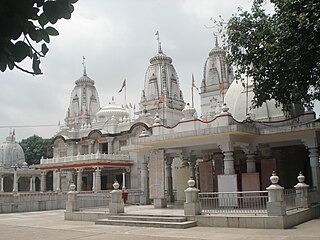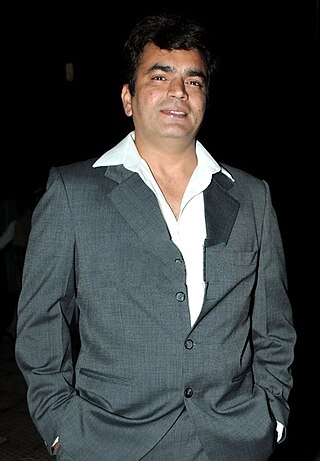Related Research Articles
Bihari languages are a group of the Indo-Aryan languages. The Bihari languages are mainly spoken in the Indian states of Bihar, Jharkhand, Uttar Pradesh, and West Bengal, and also in Nepal. The most widely spoken languages of the Bihari group are Bhojpuri, Magahi and Maithili.

Bhojpuri is an Indo-Aryan language native to the Bhojpur-Purvanchal region of India and the Terai region of Nepal and. It is chiefly spoken in eastern Uttar Pradesh, western Bihar and western Jharkhand in India as well as western Madhesh and eastern Lumbini in Nepal. Bhojpuri is also widely spoken by the diaspora of Indians descended from those who left as indentured laborers during the colonial era. It is an eastern Indo Aryan language and as of 2000 it is spoken by about 5% of India's population. Bhojpuri is a descendant of Magadhi Prakrit and is related to Maithili, Magahi, Bangla, Odia, Assamese, and other eastern Indo-Aryan languages.

Magahi, also known as Magadhi, is a Indo-Aryan language spoken in Bihar, Jharkhand and West Bengal states of eastern India, and in the Terai of Nepal. Magadhi Prakrit was the ancestor of Magahi, from which the latter's name derives.

Awadhi, also known as Audhi, is an Indo-Aryan language spoken in the Awadh region of Uttar Pradesh in northern India and in Terai region of western Nepal. The name Awadh is connected to Ayodhya, the ancient city, which is regarded as the homeland of the Hindu deity Rama, the earthly avatar of Vishnu. It was, along with Braj, used widely as a literary vehicle before gradually merging and contributing to the development of standardized Hindi in the 19th century. Though distinct from standard Hindi, it continues to be spoken today in its unique form in many districts of central Uttar Pradesh.

Sant Kabir Nagar district is one of the 75 districts of Uttar Pradesh state in northern India. Khalilabad is the district headquarters. Sant Kabir Nagar district is a part of Basti division. The total area of Sant Kabir Nagar district is 1,646 km2 (636 sq mi).

Gorakhpur district is one of the 75 districts of Uttar Pradesh state in northern India. This district is a part of the Gorakhpur division. The city of Gorakhpur, or Gorakhpur is the administrative headquarters of this district and Gorakhpur division. It borders Sant Kabir Nagar district to the west, Kushinagar and Deoria districts to the east, and Maharajganj and Azamgarh districts to the north and south.

Kaithi, also called Kayathi or Kayasthi, is a historical Brahmic script that was used widely in parts of Northern and Eastern India, primarily in the present-day states of Uttar Pradesh, Jharkhand and Bihar. In particular, it was used for writing legal, administrative and private records. It was used for a variety of Indo-Aryan languages, including Angika, Awadhi, Bhojpuri, Hindustani, Magahi, and Nagpuri.

Raja Chaudhary is an Indian television actor, writer and producer based in Mumbai. He predominantly works in the Bhojpuri cinema. In 2008, Chaudhary participated as a contestant on Colors TV's reality show Bigg Boss, where he emerged as the first runner up.

Barah Aana is a 2009 Indian black-comedy drama film written and directed by Raja Menon. The title refers to Barah and in Hindustani aanas, meaning 3/4 Rupee, which was a unit of Indian currency before decimalisation. Barah Aana stars Naseeruddin Shah, Vijay Raaz, Arjun Mathur, and Tannishtha Chatterjee. The film depicts the lives of working-class Indians in a globalized milieu and how events spiral out of control when the characters try their hands at crime.

Manoj Kumar Tiwari is an Indian politician, singer and actor serving as a Member of Parliament from North East Delhi. He contested the 2009 general election as a Samajwadi Party candidate from Gorakhpur Lok Sabha but lost to Yogi Adityanath. Again, he contested 2014 Indian general elections as a Bharatiya Janata Party (BJP) candidate and won. He was appointed as Delhi BJP president in 2016. He was the head of the BJP organisation in Delhi when the party recorded a record victory in 2017 MCD elections. He own assets with value of approximately Rs 24,28,17,031 ~24 Crore+.

Bhojpur is a ethnolinguistic and cultural area in the Indian subcontinent where the Bhojpuri language is spoken as a mother tongue. The Bhojpuri region encompasses parts of the Indian states of Bihar, Uttar Pradesh, and Jharkhand, and the Madhesh, Gandaki and Lumbini provinces of Nepal.
The Bhojpuri people, also known as Bhojpuriya-sawb are an Indo-Aryan ethnic group from the Indian subcontinent who speak the Bhojpuri-language and inhabit the Bhojpur-Purvanchal region. This area is now divided between the western part of the Indian state of Bihar, the eastern part of the Indian state of Uttar Pradesh, western Jharkhand, along with some neighbouring districts in the Madhya Pradesh and Madhesh and Lumbini of Nepal. A significant diaspora population of Bhojpuris can be found in Trinidad and Tobago, Guyana, Jamaica, Suriname, other parts of the Caribbean, Fiji, South Africa, Mauritius, United States, Canada, Netherlands, United Kingdom, Australia, and New Zealand.
Sabiha Shaikh, known professionally as Rani Chatterjee, is an Indian actress who primarily works in Bhojpuri films. One of the highest paid Bhojpuri actress, Chatterjee made her acting debut with the film Sasura Bada Paisawala (2004). The film still ranks as the highest-grossing Bhojpuri film.
Bhojpuri literature includes literature written in Bhojpuri language. Bhojpuri has developed over a course of 1300 years, the development of the language started in 7th century. The earliest form of Bhojpuri can be seen in the writings of Siddha Saints and Charyapada. Distinct literary traditions in Bhojpuri language date back to medieval periods when saints and bhakts of the region adapted a mixed language for their works.

Shatrughan Kumar Yadav, known professionally as Khesari Lal Yadav, is an Indian actor, singer, dancer and model who primarily works in Bhojpuri cinema. Also known by the Initialism KLY, Yadav has appeared in more than 70 films, and performed as vocalist in more than 5000 songs. Apart from Bhojpuri, he has also worked in Hindi, Awadhi and Haryanvi languages.

Dabang Sarkar is a 2018 Indian Bhojpuri-language action drama film directed by Yogesh Raj Mishra and produced by Deepak Kumar and Rahul Vohra. It stars Khesari Lal Yadav and Akansha Awshthi. Sanjay Pandey, Deepika Tripathi, Anoop Arora, Samarth Chaturvedi, CP Bhatt, Jayashankat Pandey, Vineet Vishal and others play supporting roles. Kajal Raghwani makes a special appearance in a song.
Sabse Bada Champion is a 2019 Indian Bhojpuri-language action romance drama film written and directed by Dhiraj Thakur and produced by Anil Kabra and Renuka Singh under banner of "India E-Commerce Ltd". It stars Ravi Kishan and Kanak Pandey in the lead role while Raju Singh Mahi, Kishan Rai, Monika Roy, Ayushi Tiwari, Brijesh Tripathi, Amit Shukla, Raj Kapoor Shahi, Heera Lal Yadav and others play supporting roles. Rakhi Sawant makes a special appearance in a item song, which making debut in Bhojpuri cinema.
Batohiya is a Bhojpuri poem written by Raghuveer Narayan in 1911. This Purbi song became very popular and George Abraham Grierson also recorded this song for Linguistic Survey of India in 1920. It has also been called the "Vande Matram" of Bhojpuri. The poem was first published in Raghuveer Patra Pushp.
Manoranjan Prasad Sinha was a Bhojpuri poet, author and professor and Principal of Rajendra College, Chapra. He is famous for his Bhojpuri poem Firangia, which he wrote in 1921 during Non-cooperation movement. He was also elected as the president of 18th Bihar Hindi Sammelan at Motihari.
Khadag Bahadur Malla (1853–1910) Pen name, Lal was a Bhojpuri writer, poet, author and journalist and the king of Majhauli Raj of Deoria in the United Provinces of Agra and Oudh. He has written Maharasa play which is the dramatic version of Bhagavata Purana. His another notable work is Sudhabund, which is the collection of 60 Kajari songs and was published in 1884.
References
- 1 2 3 4 5 Grierson 1885, p. 425.
- ↑ Grierson 1885, p. 425-426.
- 1 2 3 4 Grierson 1885, p. 426.
- ↑ Grierson 1885, p. 430-431.
- ↑ Tiwari 2019, p. 15.
- ↑ Grierson 1885, p. 428.